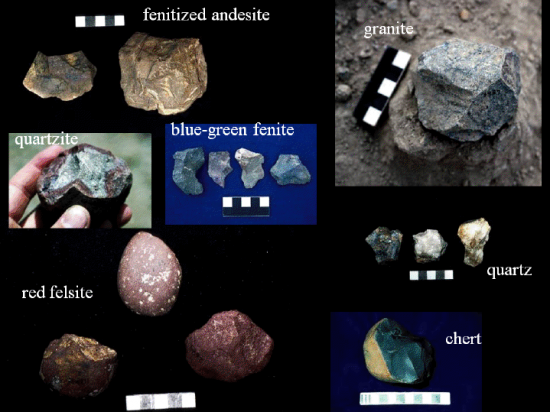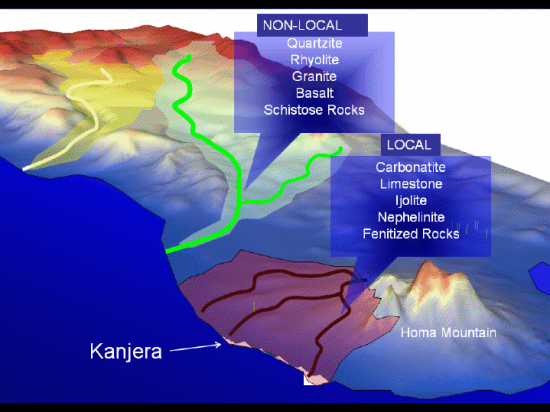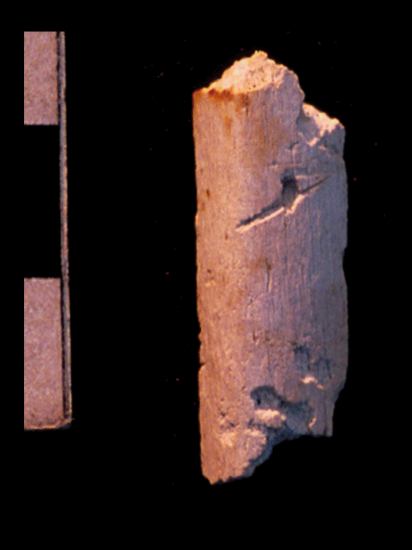PART.2
The Importance of Lithic Technology
We are very fortunate that the Homa Peninsula and its immediate environs has a geologically complex history, so that a diverse array of rocks are exposed in outcrops or as cobbles in conglomerates (Braun et al., 2008; 2009a, b). This raw material diversity is reflected in the artifact assemblages at Kanjera South, which were made using a greater variety of raw materials than typically found at most other Oldowan sites (Fig. 5) (Plummer, 2004).

Figure 5. Artifacts made from a representative sample of raw materials from Kanjera. Photo credit: Tom Plummer
Extensive raw material surveys both on and off the Homa Peninsula combined with petrological and geochemical characterization of samples collected from primary outcrops and ancient stream and river conglomerates have been used to build a lithological data base for sourcing most of the rocks used in artifact manufacture. We thus have a good idea of how far the artifacts were transported away from their sources prior to their discard at Kanjera South (Braun et al., 2008). Moreover, these rocks vary in physical properties (e.g., hardness) that can be quantified, with the harder, and often more easily flaked raw materials being found in conglomerates off the Homa Peninsula, outside of the drainage system of Homa Mountain (Fig. 6).
 Figure 6. The placement of Kanjera within the zone of the radial drainage system of the Homa Mountain carbonatite complex. Non-local “high quality” raw materials are found in conglomerates at least 10-13 km away from Kanjera. Image provided by David Braun.
Figure 6. The placement of Kanjera within the zone of the radial drainage system of the Homa Mountain carbonatite complex. Non-local “high quality” raw materials are found in conglomerates at least 10-13 km away from Kanjera. Image provided by David Braun.
Hardness is an important variable, as experiments have shown that a flake of a hard raw material, like the quartzite found off of the Homa Peninsula 10 or more km away from the site, will maintain a sharp edge much longer than a flake of a soft raw material, such as limestone, that outcrops locally. The geographic distribution of raw materials varying in their physical attributes provides an opportunity to assess aspects of hominin decision making in the selection, transport, and flaking of stone. If stone tool manufacture was not a critical component of the foraging behavior of the hominins at Kanjera, there would be little pressure to transport stone, and one would expect the artifact assemblage to be overwhelmingly dominated by locally available raw materials from the conglomerates in the radial drainage system off of Homa Mountain. What we found is that approximately 30% of the artifacts recovered from Kanjera were made from rocks that were transported to the site from conglomerates at least 10-13 km away (Braun et al., 2008). Moreover, these nonlocal raw materials were more extensively flaked, and flaked more efficiently (generating more cutting edge per unit volume) than the local raw materials found on the peninsula (Braun et al., 2009a, b). Flakes of some of the nonlocal, hard raw materials are occasionally retouched (the removal of tiny flakes from an artifact’s edge to resharpen it). Retouching is uncommon in the Oldowan, and at Kanjera it was only carried out with the hard, non-local raw materials. This again reflects the attention hominins paid to raw materials best suited for tool use. The finding that there are not nearly enough cores to account for all of the flakes at the site further hints that the artifact sample at Kanjera was part of a larger transport system. It appears that cores were being carried by hominins, for use to dispense flakes as needed for various cutting tasks.
The fact that hominins were investing energy in the transport of hard raw materials, and more efficiently reducing them, suggests that artifact manufacture was of great importance in their day-to-day lives. But what was it that they were doing with these artifacts? One certain use was animal butchery. Hominins were predominantly acquiring small antelopes the size of Grants Gazelles or a bit larger (Ferraro et al., ms). The representation of the different bones of the skeleton indicates that complete carcasses of these animals were brought to the site. Analyses of dental eruption and long bone fusion indicate that many of these antelopes were immature when they died. Damage to the fossils indicates that hominins were using stone tools to slice meat off of bones, and to break bones open for their fatty marrow. Carnivore toothmarks are also found on bones, showing that they too were interested in the carcasses at the site. But the carnivore damage largely follows the hominin damage, and appears to represent scavenging of the leftovers of the hominin meals.

Figure 7. A shaft fragment from an ungulate leg bone showing a single, deep stone tool cutmark and carnivore toothmarks. One toothmark overlays the cutmark, indicating that the hominins had stripped meat off the bone prior to carnivore gnawing. Photo credit: Tom Plummer.
The overall pattern of hominin access to the complete carcasses of small antelopes may be the signal of hominin hunting. If so, this would be the oldest evidence of hunting to date in the archaeological record. There are bones from larger antelopes and other ungulates as well, but their skeletons are not as complete, and it is unclear whether the hominins were having access to fleshy carcasses of these animals, or whether larger bovids were sometimes acquired by scavenging carnivore kills.
Artifact use-wear analysis provides another avenue for assessing the range of activities carried out by ancient hominins. We categorized the traces produced by working different materials (e.g., soft and hard wood, grass, wild tubers, animal skin and flesh) using an experimental collection of artifacts made using the same raw materials as those used by the Kanjera hominins. This use-wear reference collection was then available for diagnosing what hominins were cutting and scraping based on the use-wear of the tools found at the archaeological site. Thus far, the use-wear on the quartz and quartzite subsample of Kanjera artifacts confirms that animal butchery was conducted on-site, but also demonstrates the processing of a variety of plant tissues, including wood (for making wooden tools?) and tubers (Gibbons, 2009; Lemorini et al., 2009). This is significant, because the processing of plant materials appears to have been quite important, but would otherwise have been archaeologically invisible.
Summary and Future Research
Research at Kanjera has informed us a great deal about the habitat use and behaviors of Oldowan hominins, and about the importance of stone technology to the lives of our ancestors living 2 million years ago. Hominins were foraging in a variety of habitats, from grasslands to woodlands, and processing plant and animal foods with stone tools. Tool use seems to have been adaptively significant, as hominins preferentially utilized and transported stones that were hard, and produced flakes that held a sharp edge for a long time. Hominins consumed foods including animal carcasses and tubers that would have required stone tool use to acquire and/or process, were of high nutritional value, and came in packets large enough to be shared.
There is a great deal of more research to be carried out on the Homa Peninsula. In addition to further research at Kanjera, the next round of excavations will include several new Oldowan sites to the west and south of the Homa Mountain carbonatite complex. These sites will allow us to investigate how Oldowan hominin behavior and technology varied across different habitats, and with differential access to high quality raw material.
Literature Cited
Behrensmeyer, A.K., Potts, R., Plummer, T. W., Tauxe, L., Opdyke, N. & T. Jorstad (1995). The Pleistocene locality of Kanjera, Western Kenya: stratigraphy, chronology and paleoenvironments. Journal of Human Evolution 29:247-274.
Bishop, L., Plummer, T. W., Ferraro, J., Ditchfield, P., Braun, D., Hertel, F., Hicks, J. & R. B. Potts (2006). Recent research into Oldowan hominin activities at Kanjera South, Western Kenya. African Archaeological Review 26: 31-40.
Braun, D., Plummer, T. W., Ditchfield, P., Ferraro, J. V., Maina, D., Bishop, L. C., Potts, R. (2008) Oldowan Behavior and Raw Material Transport: Perspectives from the Kanjera Formation. Journal of Archaeological Science 35: 2329–2345.
Braun, D., Plummer, T. W., Ditchfield, P., Bishop, L. & J. Ferraro (2009a). Oldowan technology and raw material variability at Kanjera South, Kenya. In Hovers, E. & D. Braun (eds)Interdisciplinary Approaches to Understanding the Oldowan, Springer, Dordrecht, pp. 99-110.
deMenocal, P.B. (1995). Plio-Pleistocene African climate. Science 270: 53-59.
Braun, D., Plummer, T. W., Ferraro, J., Ditchfield, P. & L. Bishop (2009b). Raw material quality and Oldowan hominin toolstone preferences: Evidence from Kanjera South. Journal of Archaeological Science 36: 1605–1614
Ditchfield, P., Hicks, J., Plummer, T. W., Bishop, L. & R. Potts (1999). Current research on the Plio-Pleistocene deposits north of Homa Mountain, Southwestern Kenya. Journal of Human Evolution 36:123-150.
Ferraro JV (2007) Broken bones and shattered stones: on the foraging ecology of Oldowan hominins. PhD dissertation. University of California Los Angeles, Los Angeles, California.
Ferraro, J.V., Plummer, T.W., Pobiner, B.L., Oliver, J.S., Bishop, L.C., Braun, D.R., Ditchfield, P.W., Seaman, J.W. III, Binetti, K.M., Seaman, J.W. Jr., Hertel, F. and R. Potts. (manuscript) Earliest evidence of persistent hominin carnivory.
Gibbons, A. (2009). Of tools and tubers. Science 324: 588-589.
Lemorini, C, Plummer, T, Braun, D, Crittenden, A, Marlowe, F, Schoeninger, & P. Ditchfield (2009). Functional interpretation by use-wear analysis of 2 million-year-old Oldowan tools from Kanjera South, Kenya. Presented at the annual meetings of the Paleoanthropology Society in Chicago, Illinois, March 31 & April 1.
Plummer, T. W., Bishop, L., Ditchfield, P. & J. Hicks (1999). Research on late Pliocene Oldowan sites at Kanjera South, Kenya. Journal of Human Evolution 36:151-170.
Plummer, T. W. (2004). Flaked stones and old bones: biological and cultural evolution at the dawn of technology. Yearbook of Physical Anthropology 47: 118-164.
Plummer, T. W., Bishop, L., Ditchfield, P., Kingston, J., Ferraro, J., Hertel, F. & D. Braun (2009a). The environmental context of Oldowan hominin activities at Kanjera South, Kenya. In Hovers, E. & D. Braun (eds) Interdisciplinary Approaches to Understanding the Oldowan, Springer, Dordrecht, pp. 149-160.
Plummer T. W., Ditchfield, P.W., Bishop, L. C., Kingston, J.D., Ferraro, J.V., Braun, D. Hertel, F. & R. B. Potts (2009b) Oldest Evidence of Toolmaking Hominins in a Grassland-Dominated Ecosystem. PLoS ONE 4(9): e7199, 1-8.